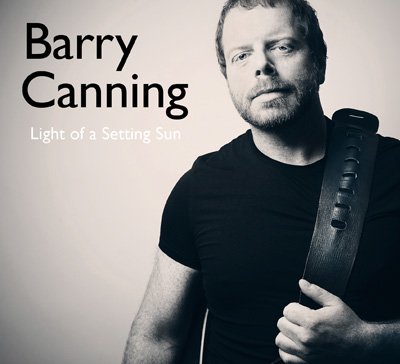
14 Jul TAKE 5 with BARRY CANNING
Today we Take Five with singer/songwriter Barry Canning. He’ll be rocking out at Salmon Fest 2017 Saturday July 15, not far from his hometown of Bishop’s Falls, NL. Most recently, Barry has been sharing the stage with Newfoundland compatriots Chris LeDrew, Cory Tetford and Paul Lamb in a series of successful in-the-round concerts.
There’s a quote from www.barrycanning.com worth sharing: “If you could combine the voices Crosby, Stills, and Nash into one, then you have captured the essence of Barry Canning the singer. If you could fuse together the writing talents of John Hiatt, Jackson Browne, and Chris Rea, then you have captured the essence of Barry Canning the songwriter.”
I think it might even be true, but to my ears, Barry’s voice stands out far beyond any singular influence he might have. There’s not a single aspect of what he does that isn’t entirely “Barry”…right down to the very chords he uses. I humbly submit that some of the most passionately in-tune major thirds ever sung by a human come from Barry (and Levon Helm). Much more than the rich warmth of his voice or the direct connections he makes with his songs, Barry is simply a kind man and a good friend. I feel like if he grew up in Mount Pearl or if I grew up in Bishop’s, our band would’ve really done something. There’s still time. I’m proud to know Barry and hope you enjoy his thoughtful responses below.
1. Barry, this is such a typical question but I’m fascinated to know your answer. When you are working on a song, does the music come first or is it the lyrics? Or is it something altogether different?
I get in song writing modes. By that, I mean I usually write a whole record when I get into that mode. My last record, I basically wrote in a month, with a few exceptions of co-writes. I think that happens after some life event that triggers my need and desire to write. When that happens, my guitar is usually in my hands. I will start strumming and playing chords, then humming or singing whatever words that come to mind, letting melody flow out. Melody, in my opinion, reflects on how I am feeling. Often, melody just appears, it isn’t forced. The only time I change it then is in the re-writing or recording process. I don’t need to be in too far of a verse pattern to start writing lyrics with a melody once it feels right. Sometimes you realize you have a chorus or a bridge, and start there.
2. You always surround yourself with top gun players. What kind of leader are you in the studio or on stage when working on original music?
I surround myself with top gun players so I don’t have to lead. I am a true believer that if I can give great players a good song, they will deliver. They will be inspired. I want them to all be in their wheelhouse and let them play. One great example of that is Chris Ledrew’s pedal steel playing on my last album “Light of a Setting Sun.” In giving what he thought each song needed, along with wine influenced suggestions from myself and producer Cory Tetford, his playing became a star of that album because of his great musicianship, his knowledge of great players before him, but also his emotional connection to each song.
Basically, I will sit in the studio, and let them feel it out. All good players will ask ” what do you think?” after laying down a part. Positive feedback is important, and 95% of the time, my direction will be slight. I usually work with the same players, and they know me well. They all know what I like, who I like, and that less is always more. I have been playing with my drummer Boomer and keyboard player Paul Kinsman for 30 years.
When I play live with the band, I see my job as being the frontman. I will work with the audience, and let the band do their job. My usual bass player, Glenn Parsons, he knows my stuff as well as I, maybe better. He leads the feel of the band, and kind of acts as MD, swinging the head of the bass, shouts here and there about pushes and stops, all the time never losing focus on the fact he needs to be entertaining for the audience too. I am not much without these players.
I have what the boys call the “hairy eyeball” on stage. If something is happening I don’t love, I can sometimes throw a look that gets the message across. I am no stranger to getting a middle finger back.
3. Has your graduate work in Religious Studies influenced your song-writing and if so, how?
Tough question. Graduate work, as you know, leaves you with much time alone, but with a head full of knowledge. That’s probably great preparation and solid groundwork for the song writing. Doing them both simultaneously is near impossible. I walked 800 kms across Spain over 30 days while working on my Master’s thesis. Wasn’t much time for song writing. As a song writer or composer, any experience is good experience. Any knowledge is good knowledge.
4. Barry, it might be said that you have a chord named after you. I know it as the “Barring Canning chord.” In my opinion, it is a defining feature of your harmonic personality. How did it come to you? What do you make of it, or is it simply “just a chord” to you and I am out to lunch?
Ha. Well this chord has become a thing with many players I know. I played so much as a solo entertainer, I was always looking for something different musically. Always trying to mix things up for my own amusement. Like letting an open B ring out while playing an A. Or never playing a C# minor in full barre position, but always playing it open. Leaving the open B and E ringing. I play my F# often like that too. Just to stop my own boredom. I also believe that a slight variation on a chord can provide great inspiration. This particular chord I stole from a friend of mine in St. John’s, John Hutton, while jamming in his music store. He added the 2 to his E major (E add 2) , and I haven’t stopped using it since. I wrote a song that night called Sleeping Lady after seeing him play it. Haven’t stopped using it since. I use it that much people got used to it. It’s the first chord I play when trying any new acoustic guitar. I try not to use it playing with other players when we are playing in E, it drives them nuts to hear the 2. But, I will squeeze it in on the last chord to end the song. I have a song on the album Last Man Standing called Small Place in The Sun. Starting on the E add 2, I move the B up to a C, the G# up to an A, leave the F#, and let B and E ring. Very moody. Insert smiley face.
Pat chimes in: so there are perhaps several Barry chords. He’s a picture of the regular E chord with an added F# as played by rock star and retired hand model Alan Doyle.

But then there’s this one, too. An open major chord voicing with the B and E ringing.

Have a listen to these two chords which Barry has personally assured me can help you take anyone deep.
5. What is your favourite food in your hometown?
In St. John’s, NL, India Gate, hands down. Best Indian food I have eaten, and I live 2 minutes from Little India in Toronto. Bobby and the gang at the gate are amazing. The food, vibe, spectacular.
In Bishop’s Falls, well I will tell you this. 2 years ago, I decided I would buy lobsters for some family. I drove 30 mins, knocked on a fisherman’s door, he got in his boat, went out into the bay, hauled his pots, brought me in 15 lobsters ($6.99 a pound). Brought them home, boiled them up, and done. Might have had bottled moose as an app. Perfect.






